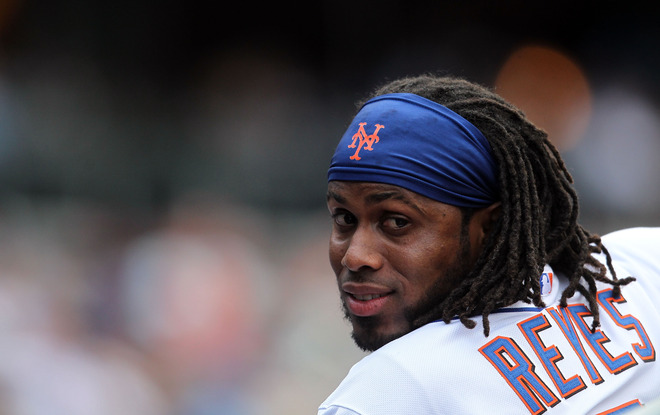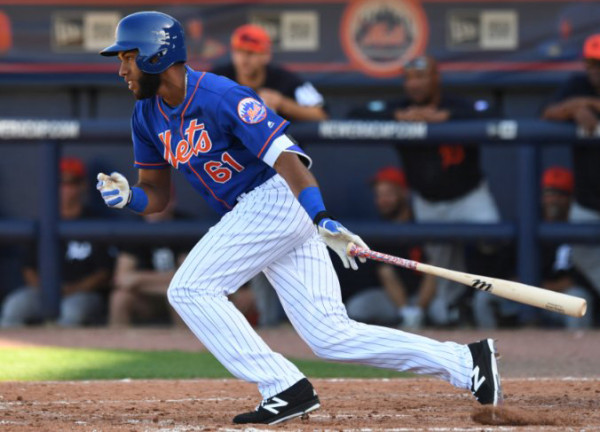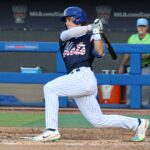
As Jose Reyes has flailed and staggered his way to a .184/.261/.286 slash line, there have been very few signs of the player he used to be.
Most of a generation has passed through the big leagues since Reyes broke in on June 10, 2003, 14 years ago almost to the day. Aside from a bevy of rehab assignments, Reyes, who received the call a day before his 20th birthday, never returned to the minor leagues. Regardless of what he has left in the tank, Reyes will be remembered as one of the greatest players in Mets team history, and will also leave fans wondering what could have been had he not been so frequently injured.
On the day Reyes was called up to meet the club in Arlington, Texas, the Mets were 27-34. The man he was called up for, Rey Sanchez, was placed on the Disabled List with a strained thumb.
On Tuesday, the Mets placed incumbent starting shortstop Asdrubal Cabrera on the DL with an eerily similar injury—a sprained thumb—but this time around, the team decided against promoting their promising young shortstop, Amed Rosario, deciding to recall T.J. Rivera instead and stick with six starters and seven relievers.
The circumstances surrounding Reyes’ call-up and the situation the Mets currently find themselves in are astoundingly similar, and yet, with Gavin Cecchini replacing yet another injured middle infielder—this time Neil Walker—it seems that Sandy Alderson is being more cautious on pulling the trigger than Steve Phillips was in 2003.
Coincidentally, two days after Phillips gave Reyes the call-up, Phillips got a different kind of call, one that informed him he would no longer be a part of the Mets organization. But his final decision as Mets general manager was one that he got 100% correct.
The 2017 version of the New York Mets is 30-35, just a few notches in the win column better than the 2003 disaster that finished 66-95. Of course, in 2003, the Mets were in rebuilding mode, and coming off of a last place finish in 2002. The 2003 arrival of Jose Reyes and the 2004 arrival of David Wright were seminal moments in the process of assembling the 2006 team that won 97 games and lost in the NLCS. It’s not inconceivable that Rosario and fellow top prospect Dominic Smith, .316/.367/.463 with Las Vegas this season, could help orchestrate similar growth.
By June of 2003, Rey Sanchez was a washed-up journeyman with a slash line—.207/.240/.236—that looks a lot like Reyes’ 2017 numbers. Sanchez played in just 18 more games for the Mets and was out of the league by 2005. Clearly, neither Asdrubal Cabrera nor Neil Walker are at this stage of their careers right now, but in a cruel twist of fate, Reyes himself has a chance of being a roster casualty whenever the Mets do decide to promote Rosario. As always seemed likely with Reyes’ reliance on his scintillating speed, his game has not aged well. Even if Rosario’s time hasn’t come yet, it most certainly will come soon.
Rosario is hitting .336/.378/.500 in 268 at-bats and has stolen 12 bases in his first season with the 51s, and his fifth season overall in the Mets organization. Reyes was hitting .269/.333/.356 in 160 AB and had 26 stolen bases at the time of his promotion. Reyes was in his first year with the Norfolk Tides, the Mets Triple-A affiliate at the time, and his fourth overall season with the organization. Rosario, 21, is a year and a half older than Reyes was in June 2003.

Stylistically, Jose Reyes and Amed Rosario’s games diverge: Reyes came up and immediately became one of the most dynamic and terrifying base stealers in the league. Rosario runs well, but won’t strike even close to the same amount of fear into opposing pitchers and catchers in that aspect of the game. Rosario is taller and stronger than Reyes was in 2003, and may end up hitting for more power. Rosario’s numbers are fantastic this year, but they come with an asterisk, as they’ve been accrued in the exceedingly hitter-friendly PCL, a reminder that scouting is not an exact science.
The differences in their career minor league numbers are nearly indistinguishable, though. Try differentiating these sets of numbers: .289/.336/.406 in 1650 AB with 17 HR or .284/.341/.419 in with 1438 AB with 16 HR; whose numbers are whose? The latter set of numbers belong to the elder statesman, Reyes, who will more than likely be inundated with questions about similarities between he and Rosario whenever the Mets do decide to promote the young stud. Although they play the game differently, there’s no denying the talent and potential: Prior to 2003, Baseball America rated Reyes as the No. 3 prospect in baseball, and prior to 2017, Baseball America assigned the No. 8 ranking to Rosario.
The 2017 Mets, as it stands on the morning of June 16, are 9.5 games behind the first place Nationals, but still believe they can compete for, and take back, the NL East crown. They have to believe this. After all, this is a team built to win now, a team that has reached the postseason in back-to-back seasons and is just 20 months removed from playing for a world championship, with much of that roster still intact. Undoubtedly, Alderson worries that the Mets fan base will see Rosario as this team’s savior, a-la-Yoenis Cespedes circa 2015, whereas Reyes was instead regarded as a breath of fresh air for a team headed for the basement.
Jose Reyes has won a batting title, a silver slugger, and been an MLB All-Star four times. Amed Rosario may accomplish all, some, or none of those things in his major league career. As with any player who has never put on a big-league uniform, there is no sure thing. But as Cabrera and Walker are on the shelf and Reyes continues to hit below his weight, it’s a sure thing that Rosario is, at the very least, one of the two or three best options to play up the middle for the Mets—certainly a better choice than Gavin Cecchini is.
Regardless of the standing of the big club, playing in New York will always be a pressure-packed experience, especially for a 21-year-old being hailed as the next Mets star. But a mid-June promotion of a top-flight shortstop prospect was good to the Mets the last time they did it, and no matter when he is promoted, Rosario will always have to handle lofty expectations to succeed in the Big Apple.
Cespedes, Steven Matz, and Seth Lugo are back, and the Mets are playing their best baseball of the year, having won five of their last seven games. This makes it even more imperative that the Mets seize the opportunity to limit the dead weight they place in the lineup on a nightly basis. The Mets can’t afford to wait long before the name “Rosario” is written in Terry Collins’ lineup card—not if this team wants to compete with the Nationals.
















